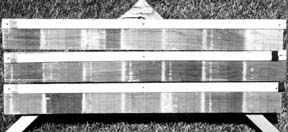
Time once again, folks, for a report on Practical Sailor’s varnish exposure test. After two years, we’re getting somewhere. In fact, for practical purposes, it’s over. It seems like a long time ago – 20 kinds of varnish were meticulously applied to matched teak boards, in 2-, 3-, 5- , and 7-coat panels, some with even more coats (if recommended by the maker).
On June 2, 2000, “The Rack,” as it came to be known, was placed outdoors (in the executive editor’s back yard) to face sun, snow, sleet, fog, smog, rain, heat, cold and the odd passing bird. The goal: Test each brand’s film integrity, gloss, and color retention. In plain language, determine which lasts the longest and looks the best.
Although it initially was checked monthly, the first thorough examination of The Rack came six months later. The findings were reported in the March, 2001 edition. Three of the two-coat panels had failed; seven other brands were starting to fail. Only two things were learned: (1) two coats of varnish don’t give teak very long-lasting protection, and; (2) color and gloss changes occur rather quickly.
Those interested in information on surface preparation, number of coats, stir or no-stir, sanding between coats, etc. can find it on the big chart that filled nearly two pages in that March, 2001 edition. Selected columns of that information are repeated in the chart below, but the main purpose of this new chart is simply to advance the results to the two-year mark, and call it a day. No one who likes brightwork on board would let things get to this point.
Because it sometimes gets confusing, even to us, an effort was made in the Nov. 15, 2001 issue to explain the four basic kinds of coatings being tested almost continuously by Practical Sailor. The four categories are bottom paints, topsides enamel, teak treatments (not including varnish) and varnish.
Considerably more guidance on how the 20 varnishes were performing was in a 12-month report that appeared in the Nov. 15, 2001 issue.
The 12-month varnish results were fairly definitive. Except for West Marine’s “breathable” Wood Pro (which probably doesn’t meet the strict definition of “varnish”), all the two-coat segments had failed. Six three-coat sections also had failed. Only six brands still had “excellent” gloss. Color changes were all over the place, some fading, some getting darker.
Summaries of pertinent 12-month data (Gloss and Film Integrity) are shown on the chart below.
Monthly checks gradually established that good data might be available by letting Nature have her way with The Rack for two full years.
The panel finally was brought inside in early June, 2002. The yardsticks that protect from exposure one segment of each panel were removed in order to compare the color and gloss with the original.
Only seven of the 20 three-coat segments were intact. Varnishes whose three-coat segments were intact also displayed intact any segment with more than three coats. (As noted at the 12-month interval, all two-coat panels had failed earlier.)
The seven survivors were Interlux Interthane (the only two-part finish), Interlux’s Schooner, West Marine’s Skipper, West Marine’s Admiral’s, Epifanes Wood Finish, Pettit’s Hi-Build 2067, and US Paint’s AwlSpar.
Next, the gloss remaining on those seven survivors was examined; and the color was compared with the original (as protected throughout the exposure by those yardsticks).
Melding the intact coats (which are, by far, the most important), the gloss and the color produced three top performers in this test.
First, with three or more coats unbroken, excellent gloss retention, and little color change was Epifanes Wood Finish. Second was Pettit’s Hi-Build 2056. Its multiple coats starting with three were unbroken, the gloss was good, and the color sustained no change. Third was West Marine’s Skipper, with three or more coats intact, good gloss, and only slight darkening of the color.
Of passing interest is the fact that the varnishes that clawed their way to the top in the testing all started out being among the darker varieties to begin with. The crystal-clear brands seemed to lose their gloss quicker and/or suffer more severe color.
This testing does not mean that one of these varnishes applied to a horizontal surface on a boat in Florida or the Caribbean would last for two years. In such locations, exposure to the sun, which does most of the damage, is more severe than in the New England locale where these tests were done.
“The Rack” could be placed outdoors for more exposure, which might produce failure points in the varnishes that best weathered the Practical Sailor test. However, considering that these three brands suffered the elements for two years, enough is enough.
At this point, the PS Bottom Line says you can’t do better than Epifanes Wood Finish, Pettit’s Hi-Build 2056 and West Marine’s Skipper.
Also With This Article
Click here to view “Varnish Exposure Results.”
Contacts – Absolute Coatings, 914/636-0700, www.lastnlast.com. Cabot, 617/345-0100, www.cabot-corp.com. Epifanes North America, 207/775-1333, www.epifanes.com. Interlux Yacht Finishes, 800/interlux, www.yachtpaint.com. Pettit Paint, 800/221-4466, www.pettitpaint.com. Sears, Roebuck & Co., 800 9PAINTS, www.sears.com. Target Coatings, 800/752-9922, www.targetcoatings.com. U.S. Paint, 314/621-0525, www.uspaint.com. West Marine, 800/262-8464. Woolsey/Z-Spar, 800/221-4466, www.pettitpaint.com.



































